Indeed, so many “Things to Do” articles for San Cristóbal are actually about day trips or tours outside of town.
But not this article! If you’re looking for what to do within San Cristóbal, this article is for you. No tours or day trips, this is just an exploration of the little ol’ town of San Cristóbal de las Casas.
After all, there’s enough cultural charm, friendly people, and good food in this lovely town to make you reconsider your departure date.
What is San Cristóbal de las Casas?
San Cristóbal de las Casas is considered the ‘cultural center’ of Chiapas, Mexico’s southmost state. It is home to a large indigenous population of the Tzotzil and Tzeltal peoples, has a unique history of political activism, and attracts an impressive melting pot of residents, expats, and visitors.
All of these factors give “San Cris” a lot of culture, color, and personality, making it very enticing to the wandering soul and nomadic traveler. Ask around and you’ll soon find someone with a story like: “I arrived here X months/years ago and I just never left!” or “I didn’t expect to stay here so long, but…”
Don’t let its size deceive you; San Cristóbal de las Casas will capture your heart if you allow yourself to slow down and enjoy this town.
What to Do in San Cristóbal de las Casas
San Cristóbal is the kind of place where you can spend your time doing a lot of activities and tours, or you can do nothing at all.
1. Take a Walking Tour of San Cristóbal
A walking tour is just about the best way to get acquainted with a new place. Wander the sights, meet other travelers, and get to know a knowledgeable local, all the while soaking up the sights, sounds, and interesting facts about your surroundings!
Free (Tip-Based) Tours vs. Per Person Tours
You have a choice between traditional tours, at a fixed cost per person, or “free” tours, which operate based on tips for the tour guide. Free tours usually cover general topics. For in-depth tours on specific topics like food, history, art, or artisanal traditions, you’ll most likely be looking at fixed price tours.
Historical/Sightseeing Tours vs. Social Tours
Another distinction you want to look out for is based on the type of content you want to hear:
- Historical and sightseeing tours through significant landmarks of time and space, or
- Social, cultural, and political tours less focused on touristic landmarks and more focused on the present-day landscape.
There’s always a bit of overlap between these two categories, but tour companies will usually have a basic description of what to expect on their tours. They want to avoid customer misunderstandings or disappointments as much as we want to avoid wasting our time!
So, when tours can be 3+ hours long and your time in town is preciously limited, it’s worth researching and comparing the different tour options to make sure you get what you want!
Our Recommendation: The Free Walking Tour
I chose to go with the Free Walking Tour, which seems to be the most popular of the tip-based walking tours.
This is the Type 2 kind of tour: an ambling discussion of the evolution of San Cristóbal. It includes a bit of history, but spends much more time on the present day: learning about indigenous cultures, local social movements, and unique artisanal products from San Cristóbal and Chiapas. For example, we heard about the effects of growth, tourism, the preservation of “authenticity,” commercialism, systematized education, pollution, and even the stray dogs of San Cris. And all of this was wrapped in a light, 2-way conversation with our jovial guide, Claudio, the kind of person who seemed to know everyone in town.
Fair warning: Have you ever been on those “tours” that feel more like directed shopping sprees under the thin guise of cultural and artisanal tourism? Well, the Free Walking Tour may take you to a chocolate shop, pox bar, textile store, and/or art gallery. It’s undeniable that these sorts of visits are profitable for the businesses, but for what it’s worth, I give them a pass.
Why? Certainly, there were moments where that little ‘Is this a trap?’ flag rose in me. But 1) I never felt pressured to purchase anything, 2) I believe they do filter for the most sustainable, authentic, and genuinely quality businesses that can educate us on the local economies, and 3) It is often easier to learn by seeing, touching, (free) tasting, etc. so why not experience this in the safety of numbers rather than individually?
If you want to understand the present-day issues of San Cristóbal, this tour is fascinating, educational, and fun. It gave me a lot of context and enthusiasm as I continued to explore San Cristóbal over the next several weeks!
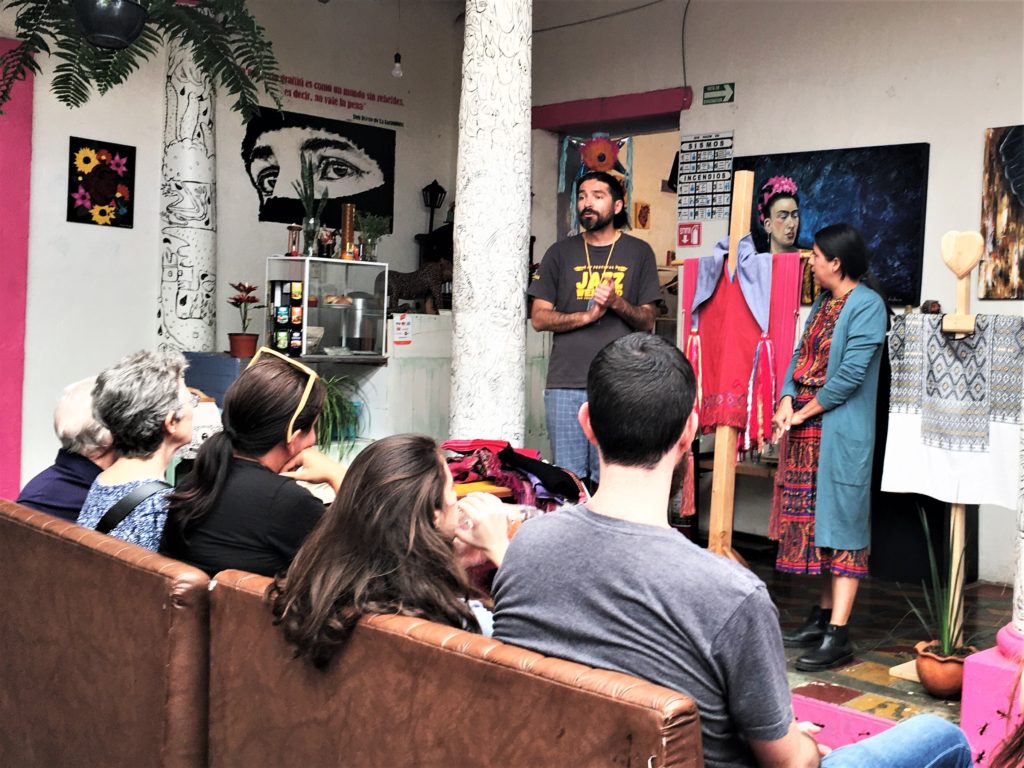
2. Take a Cooking Class with STEPS in San Cristóbal de las Casas
This was one of my favorite experiences in San Cristóbal and I highly recommend it!
STEPS is a non-governmental organization focused on the cultural preservation of indigenous peoples in and around San Cristóbal. STEPS’s projects support access to education for indigenous communities while helping them to preserve and share their traditions and stories.
STEPS has a full offering of daily events for folks like you and me:
- 11 am – Traditional Cooking Workshop (hand-made tortillas, quesadillas)
- 3 pm – Storytime in English
- 5 pm – Storytime in Spanish
- 7 pm – Traditional Cooking Workshop (hand-made tamales, ponche, and salsa)
I did the evening cooking workshop with Laura. It was a fun and laid-back night of cooking, learning, chatting, and, of course, eating! We learned about every stage of the corn-to-tamale process: from corn’s many uses to the health issues it causes to why chicken isn’t considered meat.
For example, did you know:
- There are four colors of corn: red, black, yellow, and white. All of these colors are cooked and eaten, except for red. Red corn is considered a gift from God because it grows whether or not they cultivate it (plant seeds). It is seen to bring health and luck, so you may find dried cobs of red corn hung from doorways and living rooms. This is why you can find black, yellow, and white tortillas, but never red.
- Speaking of tortillas, there are tortillas sold in tortillerías and tortillas sold hechas en mano, by hand. The tortillerías use Maseca flour, the world’s leading commercial brand masa that has been dried and ground again into flour. These tortillas, made by machine, come out highly processed and lack the nutrition, texture, and taste of traditional tortillas. Tortillas hechas en mano, on the other hand, are made in the traditional manner of cooking the corn with an alkaline solution (calcium) for 6-7 hours, letting it rest, washing it, and grinding it to produce the masa. These tortillas require much more work, but they are significantly less processed.
I could go on and on sharing the information I learned, but I won’t spoil the surprise!
We ended our time together saying “kolaval” – “thank you” in Tzotzil – to each other before enjoying our tasty meal of steaming hot tamales, roasted tomato salsa, and pox-spiked hot fruit punch.
It was 3 hours of entertainment for a low price of 200 MXN per person (10.60 USD), with an option to donate more. Proceeds go to supporting STEPS’ community projects.
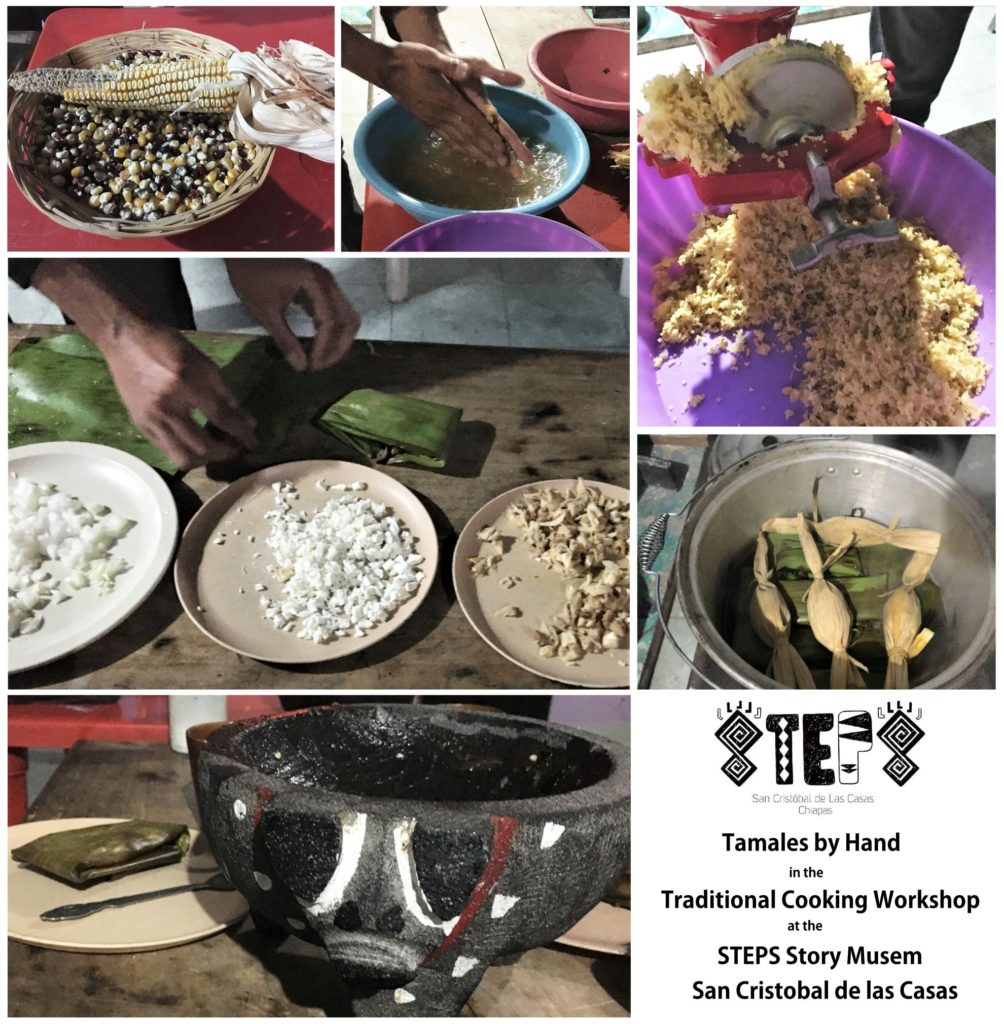
3. Wander the Streets (Without an Agenda!)
San Cris is the perfect place for agenda-less wandering. Weave your way through the town to discover the churches, plazas, shops, colorful streets, graffiti art, adorable cafeterias, and casual cafes.
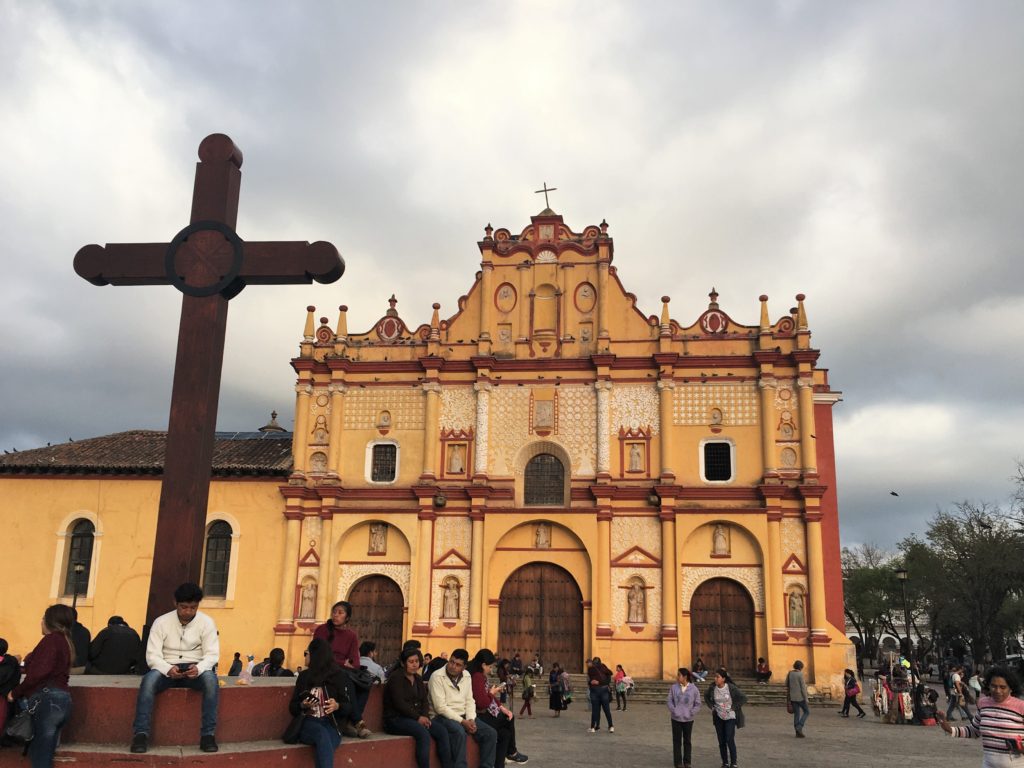
A Basic Orientation Lesson for San Cristóbal
- Nearly every city in Mexico has a zócalo, the central plaza. The zócalo in San Cristóbal is called Plaza 31 de Marzo. Along the north side of the zócalo is the San Cristóbal Cathedral with its own plaza in front (Plaza de la Paz).
- From the zócalo, there is a north-to-south pedestrian-only street and a west-to-east pedestrian-only street. These streets are lined with restaurants, bars, shopping, street vendors, and street performers. They are an amusing and thankfully exhaust-free method of getting around San Cris on foot.
- The north-to-south pedestrian walkway changes names depending on whether you’re north or south of the zócalo: South of the zócalo, it is called Miguel Hidalgo street. North of the zócalo, it is called Avenida 20 de Noviembre.
- The west-to-east pedestrian walkway is Real de Guadalupe, connecting the zócalo (the western end) to the Church of Our Lady of Guadalupe (the eastern end), though only some of this route is blocked off to cars.
A Brief Walking Tour
At the southern end of Miguel Hidalgo street is easy access to San Cris’ House of Culture, Theatre of Fine Arts, and the Church of San Cristóbal (to the west). The Church of San Cristóbal is a decent hike to reach, up red-and-white painted stairs, past gangs of stray (but friendly) dogs, but it does feel a bit like ‘getting out of the city.’ At the top, walk around behind the church, where you can enjoy the views, dirt trails through tall pines, picnic tables, and exercise machines, including a rock-climbing wall!
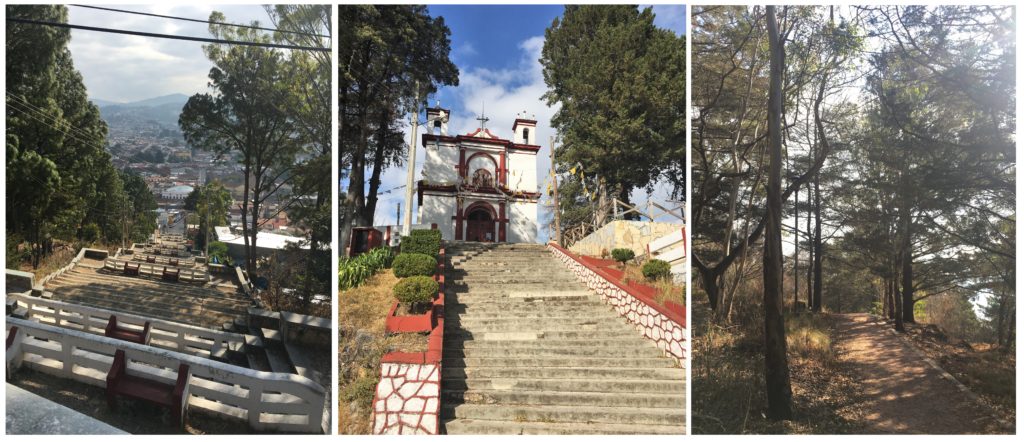
For another set of stairs to a church with beautiful views, head to the Church of Our Lady of Guadalupe. It is a steep 79 steps up, made all the harder by San Cris’ 2,200 meters of elevation, but the views from the top are some of the best you’ll find in town. At night, the lights of Real de Guadalupe twinkle from below. During the day, don’t miss the views over the agricultural neighborhood of San Nicholas – go around the church to the right.
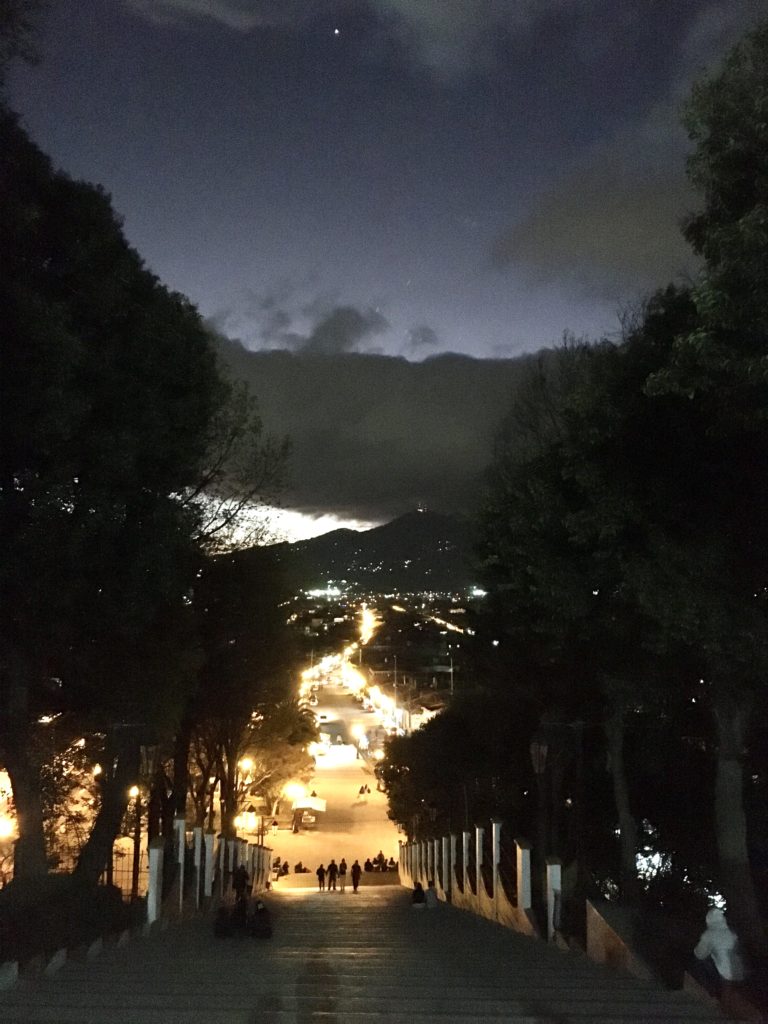
You can also find here one of the town’s best examples of syncretism (the amalgamation of different cultures that together create a special blend). For San Cristóbal, it is the mix of ancient Mayan beliefs interrupted by evangelist Spanish Catholicism. The syncretism is embodied here at the church in the green, wooden Mayan cross with Jesus Christ in the center.
Going northward from the zócalo on Avenida 20 de Noviembre will lead you to the Church of Santo Domingo, the Artisan’s Market of Santo Domingo (see next), and the Museum of Mayan Textiles (see further below).
But don’t hesitate to go off the main streets! Explore to your heart’s content San Cristóbal’s quiet, narrow streets with a wide range of cuisines offered and goods and services available. San Cristóbal has graffiti art around every corner, from the silly cartoon to the politically-charged message. The area around the Chedraui has been especially renewed with graffiti street art.
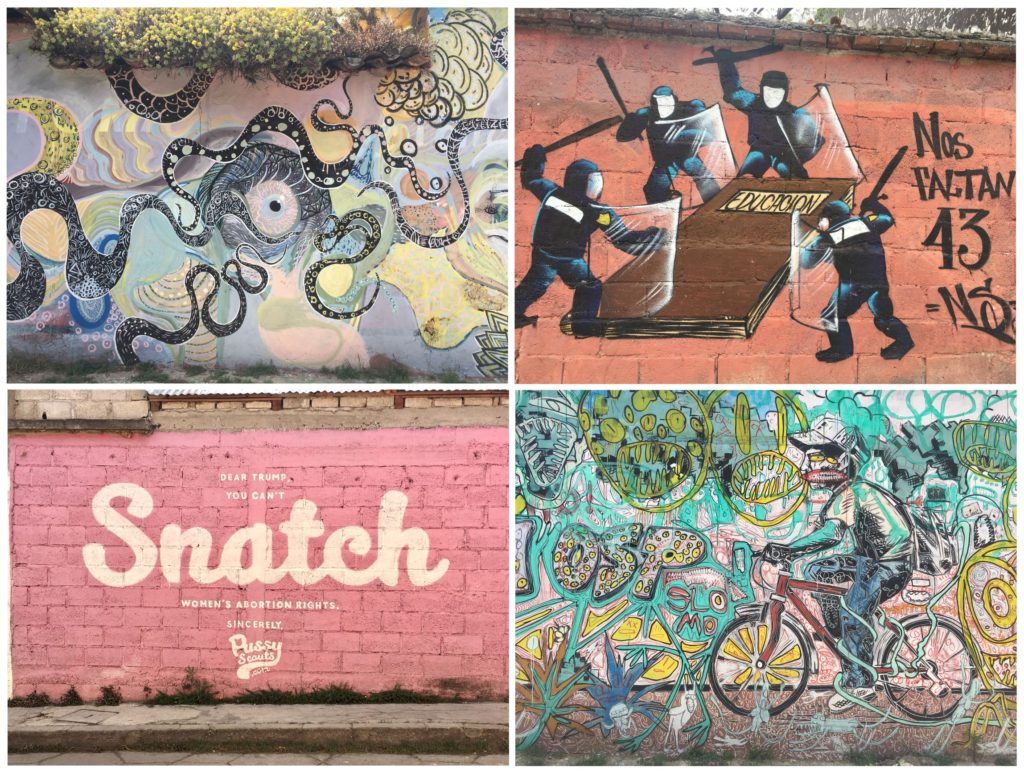
This is a truly diverse place, where you can find yoga or jiu-jitsu, live jazz or salsa dancing, high-quality medical services (teeth-cleaning, anyone?), and talleres (workshops) for Spanish language, chocolate-making, cooking (like STEPS!), music, and weaving. So many options!
4. Shop at the Mercados (Markets)
You may know already that we love Mexico’s markets. It may be the low prices, the amazing selection of foods, or the chaotic sights, sounds, and smells of so many people shopping at once, but if there is a tianguis (market) in town, we’ll be there.
San Cris conveniently has its biggest food market right next to its biggest artisan market.
Artisan’s Market of Santo Domingo
This artisanal market is a large maze of tents set up around the Temple of Santo Domingo (and its Textile Museum), four blocks north of the Zócalo (main square) along the very commercialized, pedestrian-only street, Avenida 20 de Noviembre.
In its labyrinth of colorful displays, you’ll find lots of amber, textiles, ceramics, toys, and more of your typical souvenirs. Chiapas is a haven of bright colors, so even if you’re not a souvenir or “stuff” shopper, this is a beautiful and relatively low-pressure market to wander through.
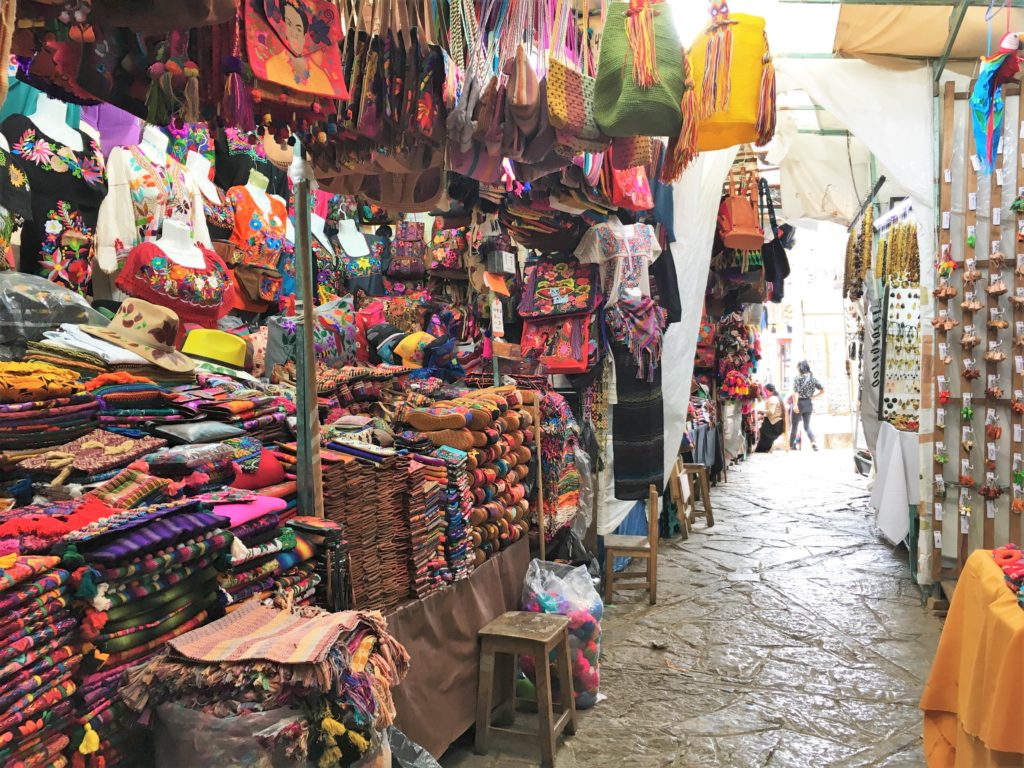
Mercado Viejo Meat & Produce Market
Just northeast from the Santo Domingo market is the food market, Mercado Viejo, accessible from Utrilla Street. This may be one of my favorite markets in Mexico. It is not too crowded or dirty or impossibly maze-like – it is the perfect tourist-friendly market without the upsurge in prices. Though it may not appear so at first sight, the market is extensive. Three different times, I thought I found a new market, but it was really just another end, another entrance, of the same market!
Also, the quality of the food! Chiapas is self-sufficient; it does not need to import any products from outside the state. Whatever it grows, it consumes. This means that the food here is all local and deliciously fresh.
From Utrilla Street, you’ll first see the open-air produce section. Heading eastward, the market becomes stalls of vegetables, fruits, herbs, flowers, cheeses, chicken, candles, woven baskets, and miscellanea. Also, unless you are vegan or vegetarian, don’t miss the large concrete carnicería room in the back, a classic example of Mexico’s raw meat markets.
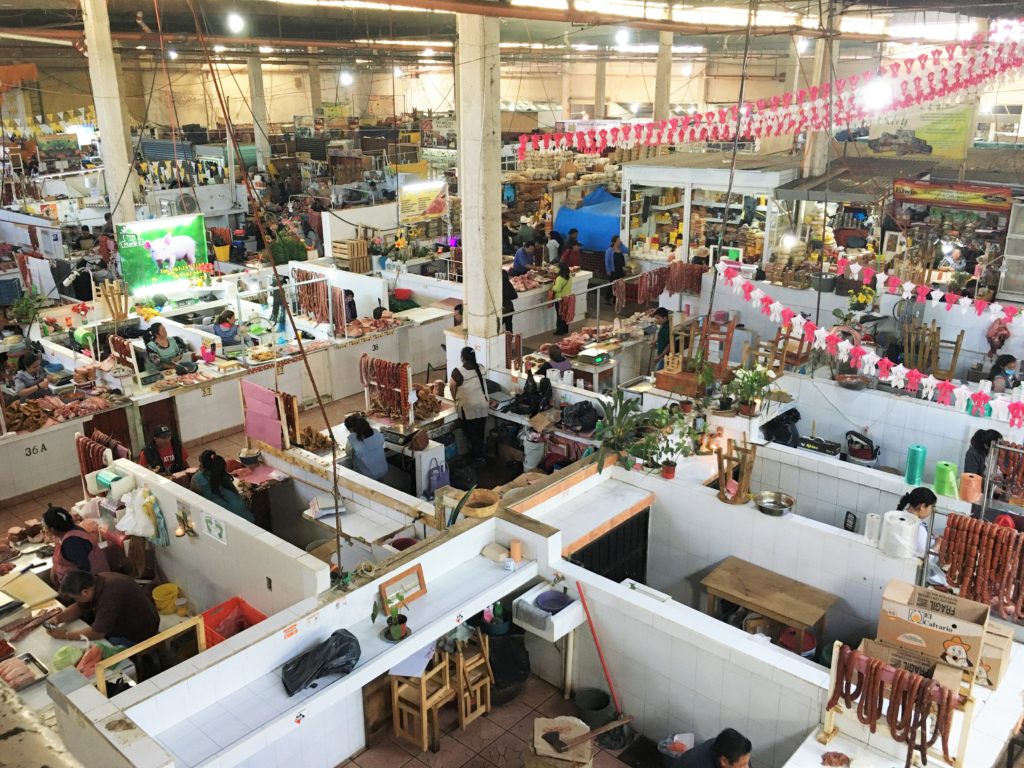
Not planning to do any cooking? No problem! The market has a prepared foods section and vendors throughout sell ready-made snacks like tamales and baked goods.
But trust me when I say: the best product you can buy at this market is the fruit. Chiapas is the time to gorge on your favorite fruits and to try out new ones. We visited during mango season, and wowee! Yesterday I bought five huge mangoes for 10 MXN, or 50 cents USD. I add it to our homemade instant pot yogurt for a tasty after-dinner dessert.
For best results, visit before noon. Vendors start packing up as early as 1 pm.
New Discoveries
Because we’ll try anything once, we made some new yummy discoveries, and some not so yummy discoveries. Of course, we encourage you to try what interests you!
Yummy 😊
- Tamarillo – This was my favorite find at this market, and I could only find one woman who had them! The tamarillo is an egg-shaped, hard-shelled tomato that tastes (at least to me) like a guava-tomato hybrid. The woman suggested I add it to salad, but I ate it like I would a kiwi or a passion fruit – cut and scoop. See the tamarillo pictured below.
- Granadilla – Consider the grenadilla a sweeter, less acidic version of the passion fruit. It is usually white or light pink inside, with crunchy seeds encased in a gelatinous membrane. Just cut the fruit in half and scoop out the seeds (membrane and all) to eat. They make healthy, low-calorie, portable snacks. I also found that in milk, they are a sweet, carb-free alternative to rice crispies cereal! Or, I mix granadilla with mango, banana, and yogurt.
- Roasted ground pumpkin seeds – Sold in aromatic mounds of red-orange to brownish powders, pepita molida is the perfect topping to guacamole, eggs, yogurt, cheese, soup, rice, pasta, toast, popcorn, etc.
- Freshwater snails – Did you know: snails are very common in Vietnamese cuisine, and after 8 months on the road I was missing home. Caracoles de agua dulce are eaten in some parts of Chiapas, scooped out from the rivers, made into caldo de shuti (snail soup). We bought a big bag of snails and some ginger and lemongrass for an excellent meal under 2 USD! We used our instant pot to steam the snails, wire cutters from our toolbox to cut off the snail tails, and wooden skewers to pull out the snail meat. An inexpensive DIY authentically Vietnamese meal in southern Mexico? Check!
Not Yummy ☹
- Nance fruit – these little yellow balls are made into syrups, ice cream, candies, and jellies, but in its raw form, I. Just. Could. Not. To me, they tasted like eating lipstick.
- Cacate fruit – these look like blackened acorns when cooked, so we were expecting nuts. Boy, were we wrong! The cacate is a white, fatty fruit encased in a hard shell. You need to crack it open with your teeth to extract the fruit. The fruit is both salty and extremely bitter, definitely something that takes getting used to.
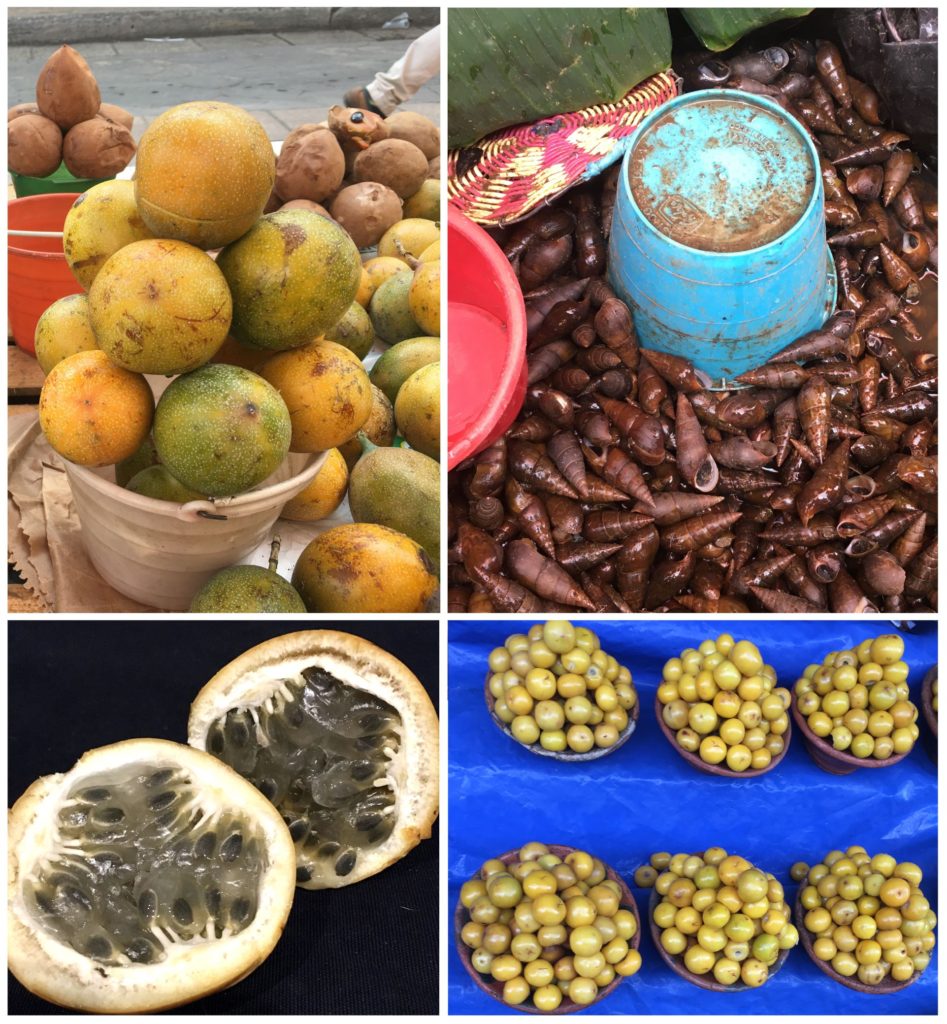
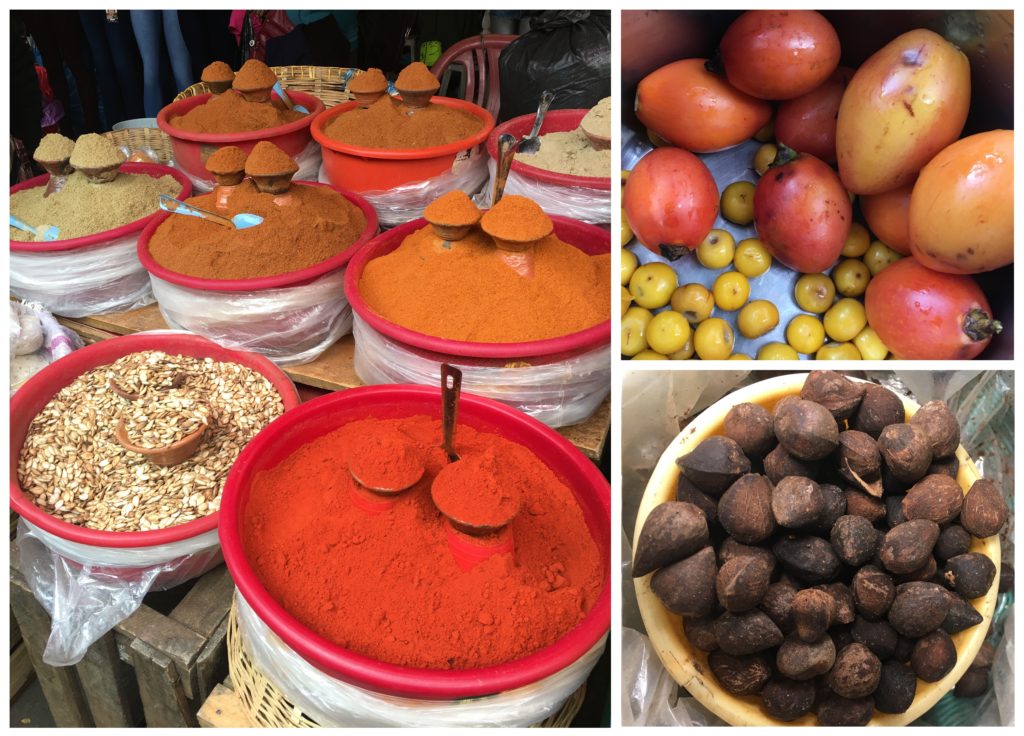
Food Market Tips
Tip #1: Once we entered Chiapas, we noticed something wonderful about fruit and vegetable vendors here that we hadn’t seen in all the rest of Mexico. In Chiapas, vendors sell their goods in aesthetically pleasing, stacked measurements, called medidas.
For example, you’ll see a stack of individual bananas, a pail of limes, a plate of peppers, a pyramid of oranges, etc. Instead of shopping by the kilo like elsewhere in Mexico, you’d ask, “Cuanto por la medida?” (How much for the measurement?).
Don’t be afraid to ask for half – “una media medida” – if you don’t want all of it. Sometimes, our eyes are bigger than our stomachs!
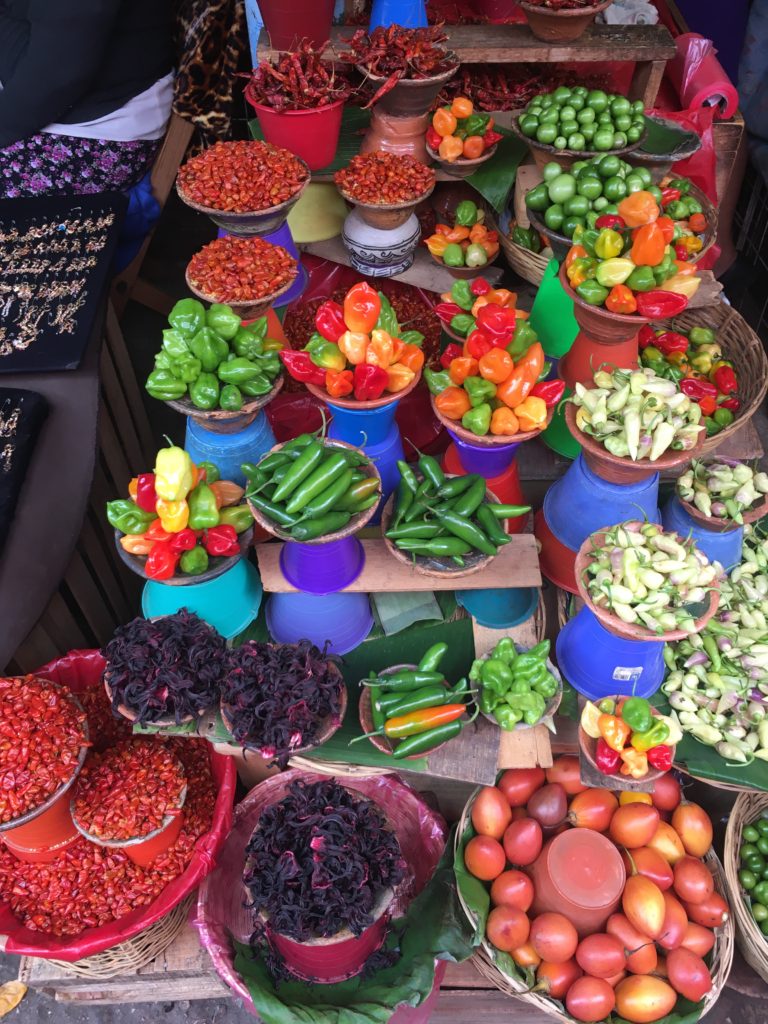
Tip #2: Bring bags from your previous grocery run to reuse for your next purchases. You’ll find that San Cristóbal is wonderfully conscientious about reducing plastic waste.
Tip #3: Find out what’s in season. We were in San Cristóbal when mangoes and oranges are at their best. The next season includes rambutan, lychee, and starfruit, which simply means we’ll have to come back here again!
Tip #4: Use a produce wash or produce soak when consuming raw foods in Mexico. We use Citro, which is made of grapefruit extract. It’s all-natural, organic and biodegradable, so you don’t need to rinse your vegetables after soaking. You can usually find it at health food stores. The more common type you’ll encounter in convenient stores is Microdyn. It works the same way, but it’s best to rinse off the chemicals before eating.
5. Visit The Textile Museum (Centro de Textiles del Mundo Maya) & Museum of the Highlands of Chiapas (Museo de Los Altos de Chiapas)
“Textiles are the most powerful forms of artistic expression within contemporary Mayan communities. Despite the near extinction of this art form at certain moments in history, today it continues to live on thanks to the tenacity and dedication of generations of women weavers, who, for over a thousand years, have passed on their knowledge to their daughters and granddaughters.”
As a sucker for narratives about traditions and inter-generational women, this introduction at the Textile Museum drew me in very quickly.
There are two museums inside the Ex-Convento de Santo Domingo: The Textile Museum (on the 2nd floor) and The Museum of the Highlands of Chiapas (on the 1st floor). One ticket gets you access to both.
Everything about these museums is beautiful: a modern design housed in the spacious, muted architecture of an ex-convent; elegant displays of textiles, ceramics, and other artifacts; and well-written and informative signage. Children (okay, adults too) will love picking out the monkeys, birds, dogs, flowers, and other motifs – even bicycles – embroidered and woven into the fabrics.
DangGoodLife Tip: In the main textile exhibit on the 2nd floor, don’t miss the drawer pull-outs encasing more examples – an automatic light turns on so you can peer as closely as you want at the fine detail work. For some reason, the museum doesn’t make these drawers obvious, but they’re the best part!
I have only two wishes for these museums: for more exhibits to be translated to English (though thankfully most of the textile room is), and for more in-depth explanations of the motifs, meanings, and differences between each community.
Overall, this museum is an excellent way to spend 2-3 hours learning more about what makes Chiapas’ indigenous communities so unique and admirable.
Cost: 65 MXN
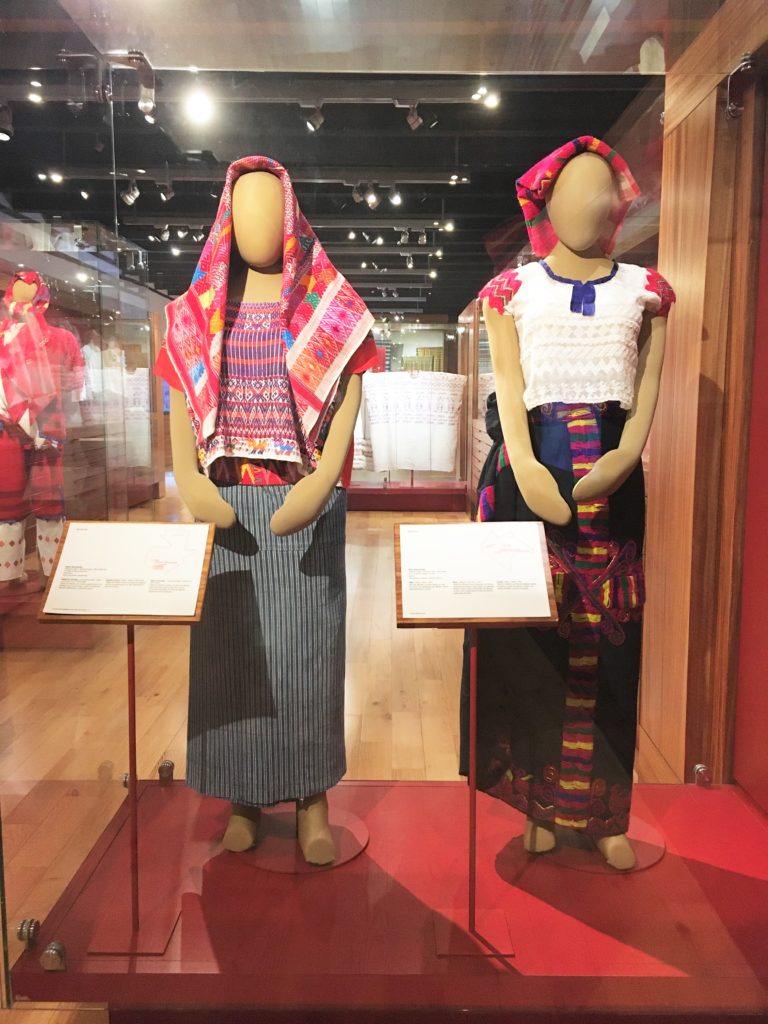
6. Visit The House of the Jaguar (Casa Na Bolom)
Casa Na Bolom (or House of the Jaguar in the local Tzotzil language) is an interesting museum-hotel-restaurant combination. It is the former home of Frans and Trudy Blom, explorers and documentarians of some of the archaeological sites, indigenous communities, and remote jungles of Chiapas.
The museum, though small, is special for its exhibits dedicated to the Lacandons, a community living in the Lacandon jungle near the border with Guatemala. You can see that the vision of the non-profit is still living and breathing in its exhibits of the past and the present.
Also, don’t miss the garden in the back, accessible from the patio behind the restaurant. It’s a peaceful place to wander: crisscrossing paths through a tall pine forest with evergreen bromeliads and flowers. According to Wikipedia, the adjoining nursery still supplies free trees to help address the deforestation problem in Chiapas.
Cost: 60 MXN

7. Try Hot Chocolate at The Kakaw Museum
You’ve seen it before: a ‘museum’ that feels just a little too commercial. I usually don’t recommend these kinds of museums, but because this one involves chocolate, I’m making an exception.
Reason 1: This mini-museum is a good place to spend some time on a Monday, when most other museums are closed.
Reason 2: Cacao and “real chocolate” are two culturally significant products that you can experience in Mexico on a relatively low budget. Unlike the Jade Museum or Amber Museum in San Cris, a visit to the museum and an optional delicious cup of chocolate energy will set you back ~$4 USD.
Reason 3: Umm… hot chocolate? The prices here are about the same as any chocolatería on Real de Guadalupe.
The Kakaw Museum is a very small (think 15 minutes) museum above a chocolatería serving a variety of chocolates and beverages. About half of the signage is in Spanish only, but the collection of all things related to cacao is impressive. I liked that they display range: differences in cacao fruits; differences in cacao drink vessels between Mexican states; differences in tools, and even how cacao is esteemed in currencies worldwide!
Imagine: In the mid-1500s, in one day of work, a man could earn 100 cacao beans (20 for a woman). What could they buy? Back then, a turkey cost 120 beans. A small rabbit: 30 beans. A pumpkin: 4 beans. It’s amazing to think about.
Cost: 30 MXN

8. Hike at Orquídeas Moxviquil: Botanical Garden
If you tire of the town’s narrow cobblestone streets and car exhaust, head up to this orchid garden at the northern edge of the town. Coming from the back of Mercado Viejo, it’s only a 20-minute walk.
While it’s a bit pricey (see pricing below), it is a nice escape for a bit of fresh air, natural beauty, and exercise (trust me, the high altitude will make you wonder what’s wrong with you!). The money also supports the University, where students from the local communities learn profitable, sustainable trades that allow them to live harmoniously with nature and replenish their land. This organization is a fantastic steward for Chiapas’ diverse flora and fauna.
Here’s how it works:
- The 50 MXN entrance gets you access to the grounds with two large, well-maintained greenhouses and a museum. If you’re into botanical gardens and bird-watching, this is definitely for you.
- Another 50 MXN gets you access to the 2 km hike/ guided walking tour. You cannot go on the trail alone due to safety concerns. There are three hikes a day, with the last one at 1 pm. There are some tours in English as well, but they are subject to availability (a.k.a. when the English-speaking interns are on-site). Even if you can’t understand the tour, the trail is (to me) the best part of this museum. I had been away from the forest for too long!
- There are also talleres available for an extra cost (I think 50 MXN, though this may vary).
Lastly, if you’re traveling with your dog, they are dog-friendly! The only rule is to pick up their poop and to keep them leashed. Otherwise, your critter will love the long hike.

9. Soak in the San Cris Atmosphere!
Last but not least, soak in the bohemian vibes, live music, and melting pot of people on the streets! San Cris is excellent for people-watching, socializing, and time spent practically doing nothing. Sit on a bench and watch people go by. Admire the different types of traditional indigenous dress. Strike up a conversation with any stranger. Trek somewhere up high to watch the sunset.
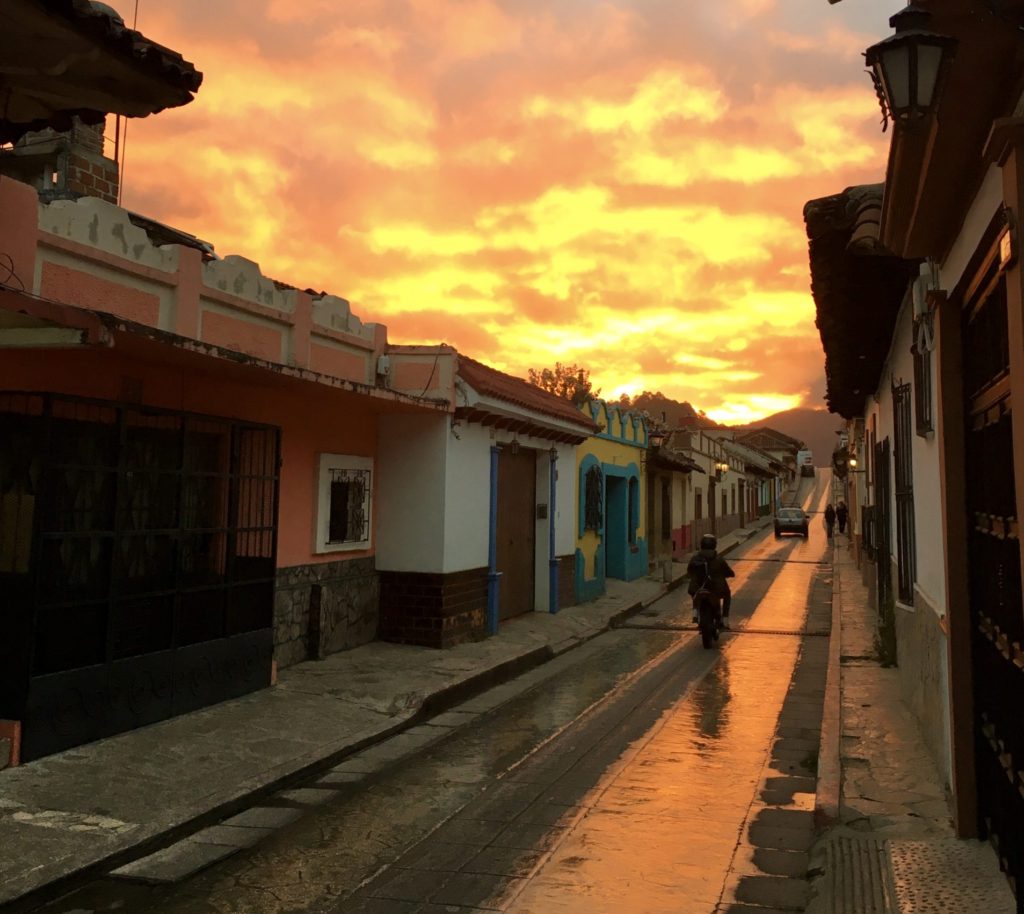
Where to Eat & Drink in San Cristóbal de las Casas
For a town in the mountains of Chiapas, San Cristóbal has a surprising culinary range thanks to the many resident expats and foreign influences. Even the Mexican food is specialized by the different states’ estilos (styles), such as Chiapan, Oaxacan, Jaliscan, etc.
Indeed, San Cris has the most diverse food scene we’ve seen since Mexico City! That may be part of the reason I didn’t mind staying for three weeks here, enjoying not just Chiapan food but also Hindi, Italian, and Brazilian meals!
And, as testimony to the types of visitors it attracts, San Cristóbal is a vegan and vegetarian paradise. Nowhere else in Mexico are the labels of ‘vegano’ and ‘vegetariano’ so mainstream, but not surprisingly so, since much of the indigenous diet is vegetarian anyway. For the low budget traveler, there are also dozens of adorable cafes and cafeterias, relaxed and affordable places off the main tourist paths.
DangGoodLife Budget Tip: The ‘Menu del Día’ is a fixed lunch package that runs no more than $100 MXN for a complete meal, from beverage to dessert. Filling up on a ‘menu del día’ special is the cheapest way to dine out anywhere in Mexico, but especially in San Cris.
Traditional Food in Chiapas
Chiapan cuisine has not become as mainstream as its northern neighbor, Oaxaca, but who needs fame when you’re warm, delicious, and hit the spot for a hungry traveler?!
As you eat, see if you can identify some distinctly Chiapan characteristics:
- An enormous range of ingredients reflecting Chiapas’ diverse terrain: grazing meats like cattle and sheep, fresh ranchero eggs and chicken, fish and shellfish of the coast and rivers, warm-weather tropical fruits, cacao, and coffee trees
- Savory mains often have slightly sweet additions, like raisins, pineapple, plantains, cinnamon, nuts, etc.
- Herbs, seeds, and vegetables work in ensemble to create layered, complex flavors.
- Dishes are supplemented with side salads, tortillas, salsas, cheeses, and avocados for a more complete, varied meal.
Caldo or Sopa
Both words mean “soup,” with lots of gray area in between. In the colder highlands of Chiapas, including San Cristóbal, a bowl of hot, aromatic, savory soup is sometimes all it takes to set things right.
In Chiapas, try:
- Sopa de Pan – Literally translated as bread soup, it is a chicken-based vegetable soup with dried and fried pieces of bread added just before eating. The magic is in the quality of the broth and the sponginess of the bread.
- Crema de Chipilín – Chipilín is among the most common herbs in Chiapas, used nowhere else in Mexico. It is added to soups, tamales, and even soap for the pleasant aroma. It’s often one ingredient of many, but a crema de chipilín will really allow you to taste the flavors of the herb.
- Chanfaína – A tripe stew similar to menudo; very rich, flavorful, and hardy. The rumor is that it’s great for hangovers!
- Pepita con Tasajo – Pepita is ground, roasted pumpkin seed and tasajo are thin strips of grilled beef. Both are common traditional ingredients for southern Mexico. The aroma alone makes me hungry!
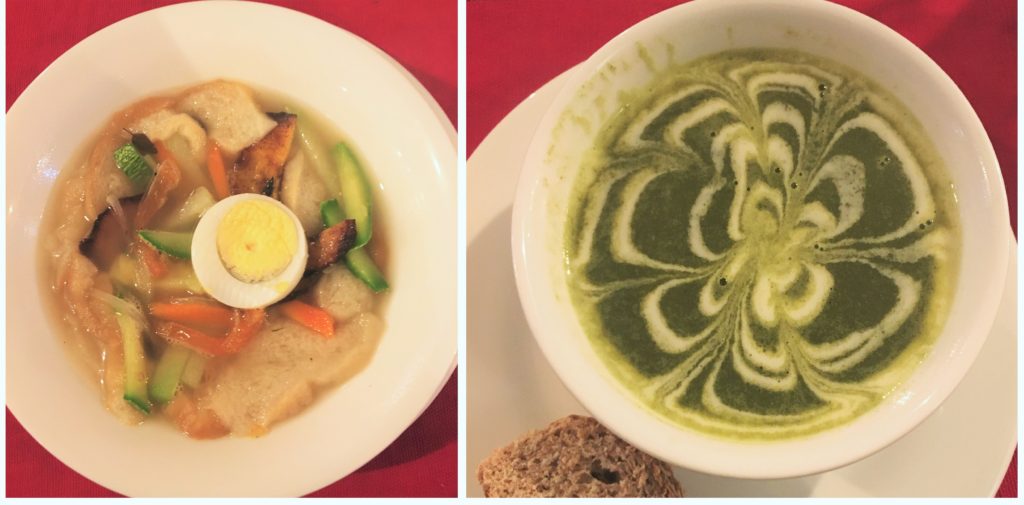
Tamales
You can’t go anywhere in Mexico without seeing a tamale vendor, but in Chiapas, tamales reign supreme as an inexpensive, warm, and filling snack or meal. There are more than 100 types of tamales throughout the region!
Savory tamales are made with any variety of ingredients: cheese, beans, vegetables, meats, herbs like hoja santa, chipilín, or azafrán (saffron), and even mole. There are also sweet tamales, made with fruits like pineapple, cheese, or even sweetened beans.
You can identify tamales easily because they’re wrapped in dried corn husks or banana leaves (usually for tamales stuffed with mole).
Mole
Unlike in Oaxaca, where each type of mole (sauce) has a distinct name, in Chiapas, it is just called mole. The most traditional version is chicken mole with a deep brown sauce characterized by unsweetened cacao.
Cochito en Horno
Cochito horneado, roasted suckling pig, is a dish often associated with Chiapas de Corzo, a town 1.5 hours west of San Cristóbal. The pork is cooked in a mixture of ancho peppers, ground spices, and herbs, and usually served in a shallow bath of its own sauce.
Our Recommendations for Food:
El Caldero is a must on cold days. I was out eating – ahem, “testing meals” for this article – by myself, so I ordered just one bowl of pork stew and one glass of beet juice. Within minutes, I had a basket of (real) corn tortilla chips with four unique salsas (cucumber guacamole, tomato onion, olive, and spicy habañero!), complimentary refried beans topped with cotija cheese and the tiny simojovel chili, a side plate of chicharron, cheese, and avocado, and my very filling, generous portion of pork stew. Oh, and I got a free pox cocktail, because I came on a Thursday (they have daily specials like free cake, pox cocktail, beer, or coffee or tea with your soup, depending on the day).
So. Much. Food. And great service to boot! I love that they asked first whether I wanted a straw with my juice or tortillas with my soup, before opening/serving them – again, San Cris cares about unnecessary waste!

Pachamama is a relatively inexpensive restaurant for its spot on Real de Guadalupe with excellent outdoor seating and people-watching. It serves pizza, pasta, burgers, and a small selection of craft beers. There’s almost always some sort of live music right in front, so bring change for the inevitable can being sent around.
El Restaurante Belil Sabores de Chiapas is beautiful enough for a classy dinner date, but casual enough to be relaxed and reasonably-priced. It uses organic, local ingredients, and the restaurant features indigenous artisanal products as part of its décor. Its soup + main meals are ~160+ MXN (8.65 USD), a bargain for the quality, environment, and service. The best part of our meal was the sopa de pan (pictured above)!
Tortillería Bats’i Waj sells authentic tortillas using real corn. Tortillas usually sell out by mid-afternoon, so come early. ¼ kilo of tortillas is just 5 MXN. Or, you can try their tortilla chips, corn nuts, and premade salsas. Take a break from eating out by picking up some tortillas, avocados, roasted pumpkin seeds, and Chiapanecan cheese for a delicious, easy picnic.
There’s never a bad meal in San Cris!
Drinks in Chiapas
In San Cristóbal de las Casas, you have options – oh so many options – for what to drink. For alcoholic beverages, you have pox (pronounced posh), craft beer, and wine. In non-alcoholic beverages, you have fruit juice, pozol, ponche, atole, hot chocolate, and coffee.
Pox
The word “poxil” in Tzotzil means “medicine, cane liquor, cure.” Pox is an alcohol made of corn, sugar, and wheat, though sugar cane may also be used. In its pure state, it is so clear it looks like water. Usually, pox is mixed with other flavors, anything from chicle (gum) to fruit, vegetables, or chocolate.
But pox is not just the casual, recreational beverage as you will see in bars and restaurants now!
Even to this day, drinking pox during Mayan rituals and religious ceremonies is believed to bring people closer to God and spirituality. It is among the oldest of Mexican alcohols, together with another of my favorites, pulque.
Seriously, I mean it: Pox has a fascinating history that you have to read about in my San Juan Chamula article – my favorite day-trip from San Cristóbal. I believe every visitor to Chiapas should learn about, and better yet experience, the small town of San Juan Chamula!
Getting back to pox, there are traditional three tiers of pox: the most alcoholic is 60%+ alcohol (like jet fuel), the medium and most common is 40%+, and the lowest tier doesn’t even taste like alcohol. The pox you see for sale is usually from the middle tier or lower, so try to get a taste before committing to any purchases (I recommend La Espirituosa; see below).
Cerveza Artesanal (Craft Beer)
Again, for a town in the mountains of Chiapas, San Cris has a lot of good craft beer. Local beers here are made of local grains – another win for sustainability!
Chiapas also has its own beer brand, Tzotzil. I tried the porter and the pale ale cacao – both were quite tasty.
Pozol, Tascalate, and Atole
Throughout our adventures in Mexico, we’ve come across so many variations of corn-based hot beverages that look so similar, with slight variations, and yet have different names. Here’s a guide to help you out:
Pozol is a drink made of masa (the same corn paste as for tamales, mentioned previously), water, sugar, and sometimes a flavoring element like cacao, honey, or chilis. It can be cold or hot, and is quite nutritious and filling.
Tescalate is a foamy, cold beverage made of ground, toasted corn, hot water, cacao, ground pine nuts, achiote, vanilla, and sugar. Achiote is a red-orange spice with a slightly tart flavor.
Atole is another hot drink made of masa, water, sugar, cinnamon, vanilla, and sometimes a flavoring element like chocolate or fruit. It can also be prepared with rice, wheat, or oatmeal, and ranges in consistency from thick porridge to thin, milky tea.
Ponche
Nothing brings back wintery holiday memories like a steaming cup of ponche on a cold night. As soon as I can’t feel my fingers, I start looking for ponche!
Ponche is a fruit punch or cider, served hot. Pretty much every version uses water and piloncillo (whole cane sugar), but the specific fruits and spices vary by the vendor. You may see guava, pineapple, apple, pear, plum, hibiscus flower, tejocote (Mexican Hawthorne), cinnamon, cardamom, anise, cloves, and even ginger.
DangGoodLife Budget Tip: Try it like a local by adding some pox to your ponche. It helps to warm your insides!
Our Recommendations for (Alcoholic) Drinks:
El Naufragio brands itself as a hidden brewery. That’s because the building is completely non-descript. The only giveaways are the loud music and the enthusiastic voices of lots of people having a very good time. El Naufragio is only open Fridays from 6 pm till the beer runs out (just about midnight, I’ve been told). And the grains are grown directly in Chiapas! There’s always a big crowd, and rightly so: this was the best craft beer we found in all of Mexico. Highly recommended!
Casa Rayuela is another brewery, west of the main square. While its beers aren’t as tasty as El Naufragio’s, they are still a welcome part of San Cris’ craft beer scene. It’s a low-key, friendly place that offers free pool (billiards) and popcorn.
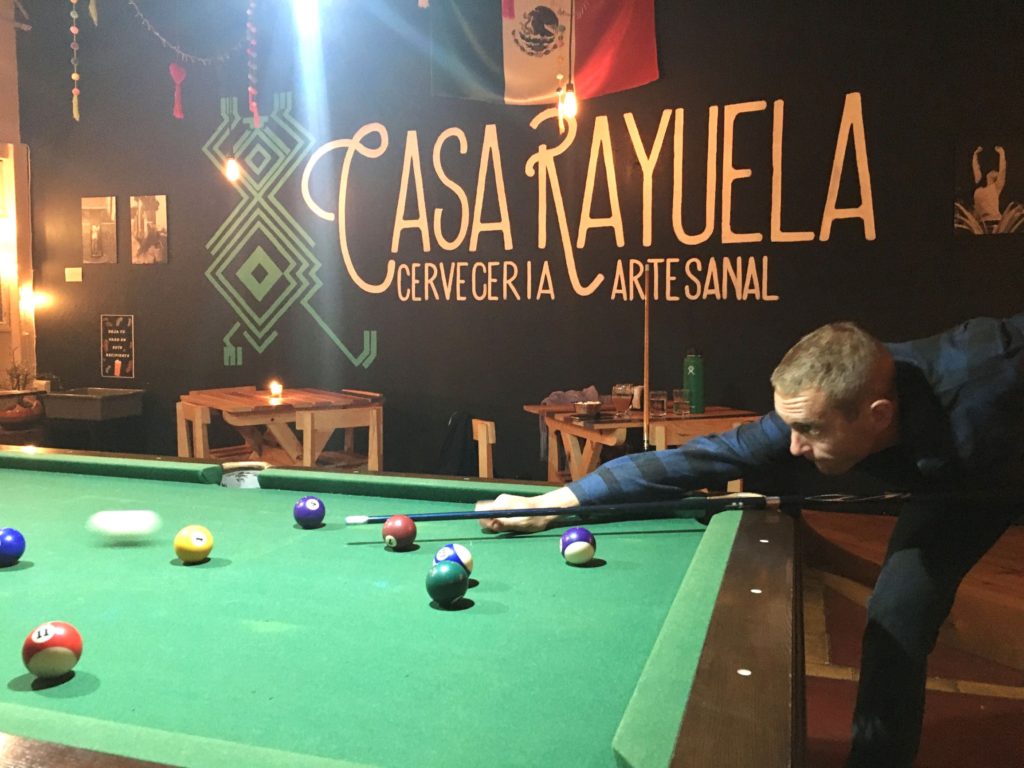
La Artisanal is a restaurant with a lot of bottled craft beers, not just from Mexico but international selections as well. Look for it in the pedestrian-only section of Real de Guadalupe.
La Espirituosa has everything: pox, craft beers, cocktails, scrumptious food, and super-friendly customer service. They’ll tell you everything you need to know about pox and maybe even San Cris. They sell the pox brand Poxna (translated from Tzotzil as the house of medicine). Poxna is distilled from 70% local white corn, 15% sugar cane, and 15% wheat. I went there to check it out, and walked away with a delicious bottle of chocolate pox (albeit a bit expensive at 250 MXN).
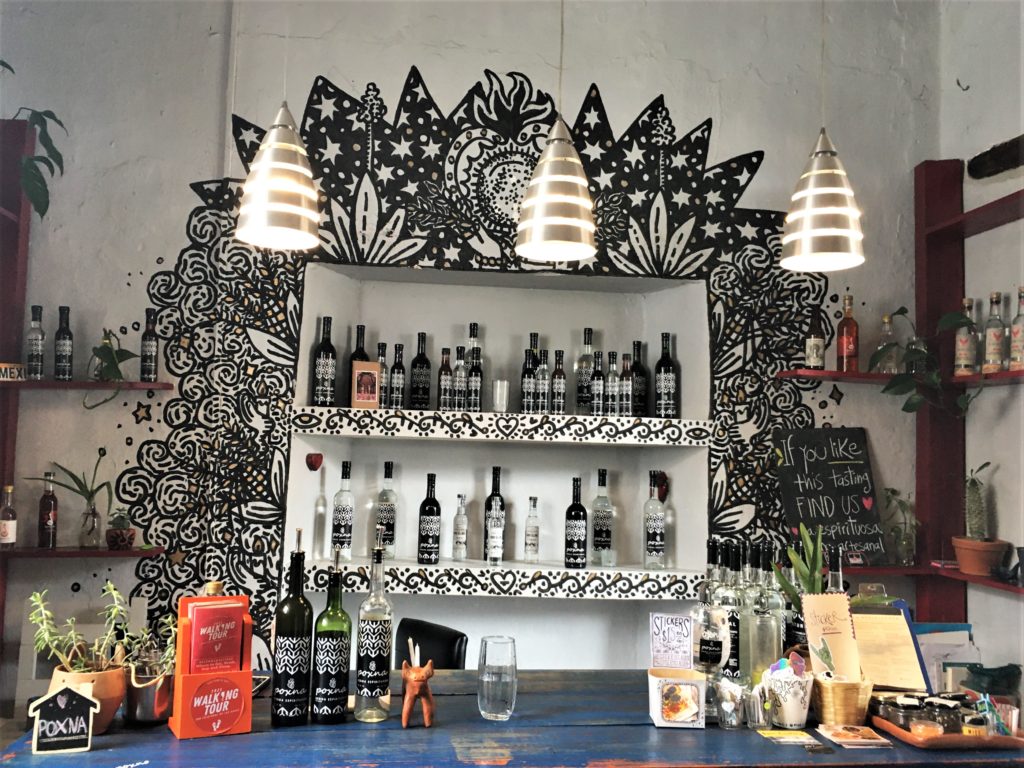
Tips to Visiting San Cristóbal de las Casas
Here are a couple of tips to help you plan your trip, whether you are boondocking or renting a place:
- Pack for / Dress in layers. The day can alternate between hot and cold very quickly. One moment you’re chilled by the wind and the next you’re sweating under the sun. Nights in the wintertime can get pretty cold.
- The mountain roads are curvy and steep. If you’re riding passenger, you may want to dose yourself up with Dramamine.
- Do not drink the water. Word on the street is that the Coca-Cola plant polluted the town’s once-clean, once-beautiful river.
- Sunscreen! At 2,200 meters of elevation in the south of Mexico (i.e. much closer to the equator), the sun is much stronger than many are accustomed to.
- Bicycles are a popular form of transportation here. Several businesses rent out bikes and lead bicycling tours outside of San Cris.
I hope this helps you to prepare for your travels in San Cristóbal de las Casas!
If you have any questions or comments, feel free to contact us at hello@DangGoodLife.com.
If this article has helped you to plan your own adventure in San Cristóbal de las Casas, please consider supporting us by shopping through our affiliate links, sharing this post, and engaging with us on our social media channels. Your support helps us keep gas in the van so that we can continue to provide this Dang Good content.
With sincere gratitude,
Lien & Jon





